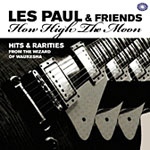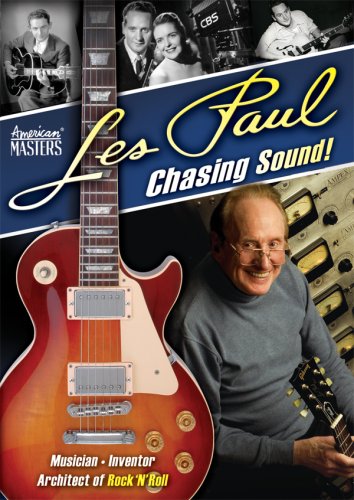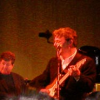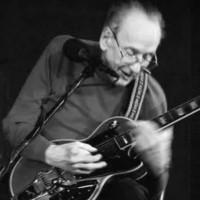Home » Jazz Musicians » Les Paul
Les Paul
Les Paul is a unique blend of musician and inventor. His performing career started at the age of 13 and by the early 1950s he was the greatest jazz guitarist of his generation. As an inventor, Les Paul's breakthrough creation of the solid-body electric guitar paved the way for electric music made the sound of rock and roll possible. In 1953 while performing with Bing Crosby, he perfected the first multi- track recording machine, allowing separate lines of instrumental music and vocals to be blended together. His many recording innovations--including sound-on-sound, overdubbing, reverb effects, and multi-tracking--greatly accelerated the advancement of studio recording. One of the most influential figures in the development of modern music-making, Les Paul developed an interest in both music and electronics very early in his life. Born in Waukesha, Wisconsin in 1915, by the age of nine he started teaching himself the guitar (having already tackled the harmonica and moved on from the piano and the banjo) and constructed his first crystal radio; within a year he had fabricated a primitive recording machine out of parts culled from a Cadillac and a dentist drill. By 13 he was performing semi-professionally as a country musician and began pursuing experiments to electrically amplify his instrument. Initial attempts involved the use of a record player needle, the earpiece from a telephone, and cannibalized radio components. Years later, the system was perfected with the replacement of the hollow guitar body with a solid block of wood: one of the earliest designs for what eventually came to be known as the solid body electric guitar. During his high school years Paul became a member of Rube Tronson's Cowboys, and shortly afterwards dropped out to work full-time with Wolverton's Radio Band on radio station KMOX in St. Louis. By the 1930s he had relocated to Chicago, where he began his recording career using the hillbilly persona of 'Rhubarb Red', maintaining at the same time a parallel career in jazz as Les Paul. His first trio was assembled in 1937, but the following year he moved to New York to work as a featured player on the radio broadcasts of Fred Waring's Pennsylvanians -- a job that was brought to an abrupt end in 1941 when he was nearly electrocuted during a session in his basement. On a more positive note, 1941 also saw the creation of the "The Log", the culmination of his efforts to create an electric guitar.
Read moreTags
Les Paul: How High The Moon: Hits & Rarities From The Wizard of Waukesha

by George Kanzler
His name is on the classic Gibson guitar and his role in the development of the electric guitar, as well as in the creation of multi-track recording and overdubbing, is indisputable. But even though he spent the last two-plus decades of his life holding forth, as much as raconteur as musician, on Monday nights (Fat Tuesday's and, later, Iridium), Les Paul, who died at 94 last summer (2009), won't be remembered as a jazz musician. His musical tastes ran closer ...
Continue ReadingRemembering Les Paul... with Lyrics!

by Randee Mia Berman
They called him the Wizard of Waukesha, and we're not talking Harry Potter. I'd first heard about Les Paul from my parents. My Mom played mandolin; my Dad was a jazz pianist, who raised me on Irving Berlin and Cole Porter. I remember listening to the famous guitar/vocal duets between Les Paul & Mary Ford, only later learned that Mary sang duets and trios with herself in songs like How High the Moon and Blue Skies, using the ...
Continue ReadingLes Paul Live At Iridium, NYC

by AAJ Staff
Les Paul Iridium New York, New York Any Monday Night
It was 46 degrees in the rain, and 9:45p.m. outside the Iridium Jazz Club on Broadway. Yet there was a huge queue for Les Paul, the inventor of the solid body electric guitar, developer of multitracking and, now 93, about to play his third set of the night at Iridium. Paul plays at Iridium every Monday and first played professionally as a boy in ...
Continue ReadingLes Paul: Jazz Guitarist

by Samuel Chell
Perhaps the greatest revelation of Chasing Sound, the DVD based on the recent Public Broadcasting Service telecast of the career of Les Paul, is that the icon is still a conscious, thinking human being and performing musician. After that dubious birthday album American Made/World Played (EMI, 2005), which trumpeted the return of the inventor of the electric guitar to the recording studio for the first time in 27 years, then covered up his playing with present-day rock-star guitarists, a listener ...
Continue ReadingLes Paul: Chasing Sound!

by Charlie B. Dahan
Les Paul Chasing Sound! Koch Vision 2007
I dare anyone to spend the time to find one musician who can say they have not had their musical career influenced by Les Paul. Maybe they aren't aware of his career as a country and jazz great, but if they play guitar, record or listen to music from the last 50 years, they have been touched in part by the master, the wizard, himself, ...
Continue ReadingLes Paul: Now!

by AAJ Staff
By Jennifer Odell
If you're craving new Les Paul tunes, the fourth generation release, Now! , is not where you'll find them. Not because it's not a great album--it is. Classical artist Michael J. Dutton's remastering allows you to hear more delicate elements of the different guitars' various tones and textures. But this album was originally conceived as a compilation for Les Paul. And now the compilation has been released three times without changing much. Most of the ...
Continue ReadingLes Paul's Innovations Paved the Way for Rock 'N' Roll

Source:
Michael Ricci
The virtuoso picker influenced a generation of guitarists and had a series of hits in the '50s with wife Mary Ford. He invented an early solid-body electric guitar and pioneered new recording methods.
Les Paul was often called rock royalty, but for the people who knew the man before his death Thursday at age 94, that term often inspired a gentle chuckle.
Born in Wisconsin in 1915, Paul was a Midwestern jazz man who went on to make high-polish 1950s ...
read more
Jazz Guitarist Howard Alden Reflects on the Life of Les Paul

Source:
Michael Ricci
Today, in New York, at White Plains Hospital, guitar legend, Les Paul died of complications from pneumonia. He was 94 years old. Aside from having what any of us would consider to be a good run in the longevity department, Les Paul also realized great quality of life achievements within the quantity of his years. Since the birth of rock and roll, every kid with a dream wanted to own a Gibson Les Paul guitar; the six-string electric named for ...
read more
Rock Hall Issues Statement Regarding Les Paul's Death

Source:
Just Roots PR
In response to the death of 1988 Rock and Roll Hall of Fame Inductee Les Paul, the Rock Hall has issued the following two statements: “Without Les Paul, we would not have rock and roll as we know it,” said Terry Stewart, president and CEO of the Rock and Roll Hall of Fame and Museum. “His inventions created the infrastructure for the music and his playing style will ripple through generations. He was truly an architect of rock and roll.” ...
read more
Les Paul Passes Away at 94: 1915-2009

Source:
All About Jazz
The World Has Lost a Remarkable Innovator and Musician New York, NY - August 13, 2009 - Les Paul, acclaimeimed guitar player, entertainer and inventor, passed away today from complications of severe pneumonia at White Plains Hospital in White Plain, New York, surrounded by family and loved ones. He had been receiving the best available treatment through this final battle and in keeping with his persona, he showed incredible strength, tenacity and courage. The family would like to express their ...
read more
Rock Hall Will Honor Music Innovator Les Paul

Source:
All About Jazz
CLEVELAND (AP) -- The Rock and Roll Hall of Fame will pay tribute to the “father of the electric guitar" this fall. Les Paul will be honored at the annual American Music Masters series, a weeklong event that begins Nov. 10, Rock Hall officials said Tuesday. A tribute concert -- artists will be named later -- is scheduled Nov. 15 at Cleveland's State Theater. Paul, 93, is hoping to attend, said Rock Hall President and CEO Terry Stewart. “You have ...
read more
Mingus Legacy (Tue) Paul Nash Jazz Cycles (Wed) Jan. 21-27 David "Fathead" Newman 75th Birthday All-Stars at the Iridium Jazz Club

Source:
Jim Eigo, Jazz Promo Services
IRIDIUM JAZZ CLUB 1650 BROADWAY (Corner of 51st) NEW YORK, NY 10023 RESERVATIONS: 212-582-2121 Sets At 8:30 & 10:30PM EVERY TUESDAY MINGUS LEGACY Sets at 8:30 & 10:30PM This Tuesday, January 21, 2008 Mingus Big Band Jan. 23 PAUL NASH JAZZ CYCLES Kenny Rampton (trumpet) Bruce Williamson (soprano & alto sax) Tim Ries (tenor sax) Mick Rossi (piano) ...
read more
Mingus Legacy (Tue) Judy Kuhn (Thu 7PM) Jan. 9-13 Kenny Garett at the Iridium Jazz Club

Source:
Jim Eigo, Jazz Promo Services
IRIDIUM JAZZ CLUB 1650 BROADWAY (Corner of 51st) NEW YORK, NY 10023 RESERVATIONS: 212-582-2121 Sets At 8:30 & 10:30PM EVERY TUESDAY MINGUS LEGACY Sets at 8:30 & 10:30PM This Tuesday, January 8, 2008 MINGUS DYNASTY Mingus Orchestra Tuesday, January l5, 2008 This Week At Iridium THURSDAY, JANUARY 10TH AT 7PM ONY AWARD WINNER JUDY KUHN Jan 13 Jeri Sager 6.00pm - 7.00pm Jan 13 ...
read more
Les Paul (Mon) Mingus Legacy (Tues) Dave Stryker Organ Trio (Wed) Dr. Lonnie Smith Trio (Thu-Sun) at the Iridium Jazz Club

Source:
Jim Eigo, Jazz Promo Services
IRIDIUM JAZZ CLUB 1650 BROADWAY (Corner of 51st) NEW YORK, NY 10023 RESERVATIONS: 212-582-2121 Sets At 8:30 & 10:30PM Les Paul Sets Remain at 8:00 & 10:00PM EVERY MONDAY LES PAUL AND HIS TRIO JOHN COLIANNI - PIANO - LOU PALLO - GUITAR, NICKI PARROTT - BASS EVERY TUESDAY MINGUS LEGACY Sets at 8:30 & 10:30PM This Tuesday, January 1, 2008 MINGUS ...
read more
Iridium Jazz Club January Schedule

Source:
Jim Eigo, Jazz Promo Services
IRIDIUM JAZZ CLUB 1650 BROADWAY (Corner of 51st) NEW YORK, NY 10023 RESERVATIONS: 212-582-2121 Sets At 8:30 & 10:30PM Les Paul Sets Remain at 8:00 & 10:00PM EVERY MONDAY LES PAUL AND HIS TRIO JOHN COLIANNI - PIANO - LOU PALLO - GUITAR, NICKI PARROTT - BASS EVERY TUESDAY MINGUS LEGACY Sets at 8:30 & 10:30PM EVERY THURSDAY BEGINNING JANUARY 10TH AT 7PM
read more
Mingus Legacy (Tues) Vince Giordano and His Nighthawks (Wed) Chuck Mangione (Thu-Sun) at the Iridium Jazz Club

Source:
Jim Eigo, Jazz Promo Services
IRIDIUM JAZZ CLUB 1650 BROADWAY (Corner of 51st) NEW YORK, NY 10023 RESERVATIONS: 212-582-2121 Sets At 8:30 & 10:30PM Les Paul Sets Remain at 8:00 & 10:00PM Effective immediately, minimums are $10/person/set for all shows except Les Paul - $15 mins. EVERY TUESDAY MINGUS LEGACY Sets at 8:30 & 10:30PM This Tuesday, December 25th This Week At Iridium Dec. 26 VINCE GIORDANO AND HIS ...
read more



























